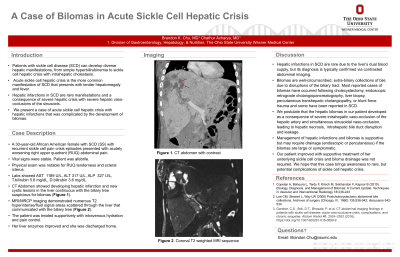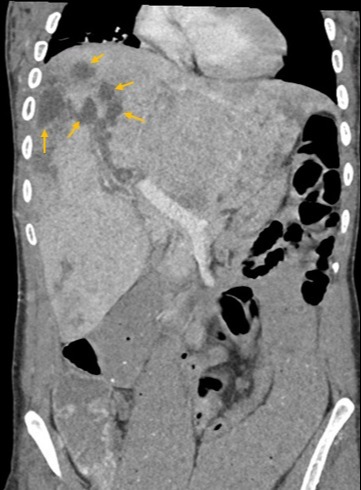Sunday Poster Session
Category: Liver
P1095 - A Case of Bilomas in Acute Sickle Cell Hepatic Crisis
Sunday, October 22, 2023
3:30 PM - 7:00 PM PT
Location: Exhibit Hall

Has Audio
- BC
Brandon Chu, MD
The Ohio State University Wexner Medical Center
Columbus, OH
Presenting Author(s)
Award: Presidential Poster Award
Brandon Chu, MD1, Chathur Acharya, MBBS2
1The Ohio State University Wexner Medical Center, Columbus, OH; 2Ohio State University, Columbus, OH
Introduction: Patients with sickle cell disease (SCD) can develop diverse hepatic manifestations, from simple hyperbilirubinemia to sickle cell hepatic crisis with intrahepatic cholestasis. Acute sickle cell hepatic crisis is the more common manifestation of SCD that presents with tender hepatomegaly and fever. Hepatic infarctions in SCD are rare manifestations and a consequence of severe hepatic crisis with severe hepatic vaso-occlusions of the sinusoids. We present a case of acute sickle cell hepatic crisis with hepatic infarctions that was complicated by the development of bilomas.
Case Description/Methods: A 30-year-old African American female with SCD (SS) with recurrent sickle cell pain crisis episodes presented with worsening right upper quadrant (RUQ) abdominal pain. She was afebrile. Exam was notable for RUQ tenderness and scleral icterus. Labs showed AST 1189 U/L, ALT 317 U/L, ALP 327 U/L, T.bilirubin 5.6 mg/dL, D.bilirubin 3.6 mg/dL. Commuted tomography showed developing hepatic infarction and new cystic lesions in the liver continuous with the biliary tree suspicious for bilomas. Magnetic resonance cholangiopancreatography demonstrated numerous T2 hyperintense/fluid signal areas scattered through the liver that communicated with the biliary tree. The patient was treated supportively with intravenous hydration and pain control. Her liver enzymes improved and she was discharged home.
Discussion: Hepatic infarctions in SCD are rare due to the liver’s dual blood supply. Diagnosis is confirmed by contrasted abdominal imaging. Bilomas are well-circumscribed, extra-biliary collections of bile due to disruptions of the biliary tract. Most reported cases of bilomas have occurred following cholecystectomy, endoscopic retrograde cholangiopancreatography, liver biopsy, percutaneous transhepatic cholangiopathy, or blunt force trauma and some have been reported in SCD. We postulate that the hepatic bilomas in our patient developed as a consequence of severe intrahepatic vaso-occlusion of the hepatic artery and simultaneous sinusoidal vaso-occlusion, leading to hepatic necrosis, intrahepatic bile duct disruption and leakage. Management of hepatic infarctions and bilomas is supportive but may require drainage (endoscopic or percutaneous) if the bilomas are large or symptomatic. Our patient improved with supportive treatment of her underlying sickle cell crisis and biloma drainage was not required. We hope that this case brings awareness to rare, but potential complications of sickle cell hepatic crisis.

Disclosures:
Brandon Chu, MD1, Chathur Acharya, MBBS2. P1095 - A Case of Bilomas in Acute Sickle Cell Hepatic Crisis, ACG 2023 Annual Scientific Meeting Abstracts. Vancouver, BC, Canada: American College of Gastroenterology.
Brandon Chu, MD1, Chathur Acharya, MBBS2
1The Ohio State University Wexner Medical Center, Columbus, OH; 2Ohio State University, Columbus, OH
Introduction: Patients with sickle cell disease (SCD) can develop diverse hepatic manifestations, from simple hyperbilirubinemia to sickle cell hepatic crisis with intrahepatic cholestasis. Acute sickle cell hepatic crisis is the more common manifestation of SCD that presents with tender hepatomegaly and fever. Hepatic infarctions in SCD are rare manifestations and a consequence of severe hepatic crisis with severe hepatic vaso-occlusions of the sinusoids. We present a case of acute sickle cell hepatic crisis with hepatic infarctions that was complicated by the development of bilomas.
Case Description/Methods: A 30-year-old African American female with SCD (SS) with recurrent sickle cell pain crisis episodes presented with worsening right upper quadrant (RUQ) abdominal pain. She was afebrile. Exam was notable for RUQ tenderness and scleral icterus. Labs showed AST 1189 U/L, ALT 317 U/L, ALP 327 U/L, T.bilirubin 5.6 mg/dL, D.bilirubin 3.6 mg/dL. Commuted tomography showed developing hepatic infarction and new cystic lesions in the liver continuous with the biliary tree suspicious for bilomas. Magnetic resonance cholangiopancreatography demonstrated numerous T2 hyperintense/fluid signal areas scattered through the liver that communicated with the biliary tree. The patient was treated supportively with intravenous hydration and pain control. Her liver enzymes improved and she was discharged home.
Discussion: Hepatic infarctions in SCD are rare due to the liver’s dual blood supply. Diagnosis is confirmed by contrasted abdominal imaging. Bilomas are well-circumscribed, extra-biliary collections of bile due to disruptions of the biliary tract. Most reported cases of bilomas have occurred following cholecystectomy, endoscopic retrograde cholangiopancreatography, liver biopsy, percutaneous transhepatic cholangiopathy, or blunt force trauma and some have been reported in SCD. We postulate that the hepatic bilomas in our patient developed as a consequence of severe intrahepatic vaso-occlusion of the hepatic artery and simultaneous sinusoidal vaso-occlusion, leading to hepatic necrosis, intrahepatic bile duct disruption and leakage. Management of hepatic infarctions and bilomas is supportive but may require drainage (endoscopic or percutaneous) if the bilomas are large or symptomatic. Our patient improved with supportive treatment of her underlying sickle cell crisis and biloma drainage was not required. We hope that this case brings awareness to rare, but potential complications of sickle cell hepatic crisis.

Figure: Figure 1. CT abdomen highlighting hepatic bilomas (arrows)
Disclosures:
Brandon Chu indicated no relevant financial relationships.
Chathur Acharya indicated no relevant financial relationships.
Brandon Chu, MD1, Chathur Acharya, MBBS2. P1095 - A Case of Bilomas in Acute Sickle Cell Hepatic Crisis, ACG 2023 Annual Scientific Meeting Abstracts. Vancouver, BC, Canada: American College of Gastroenterology.

